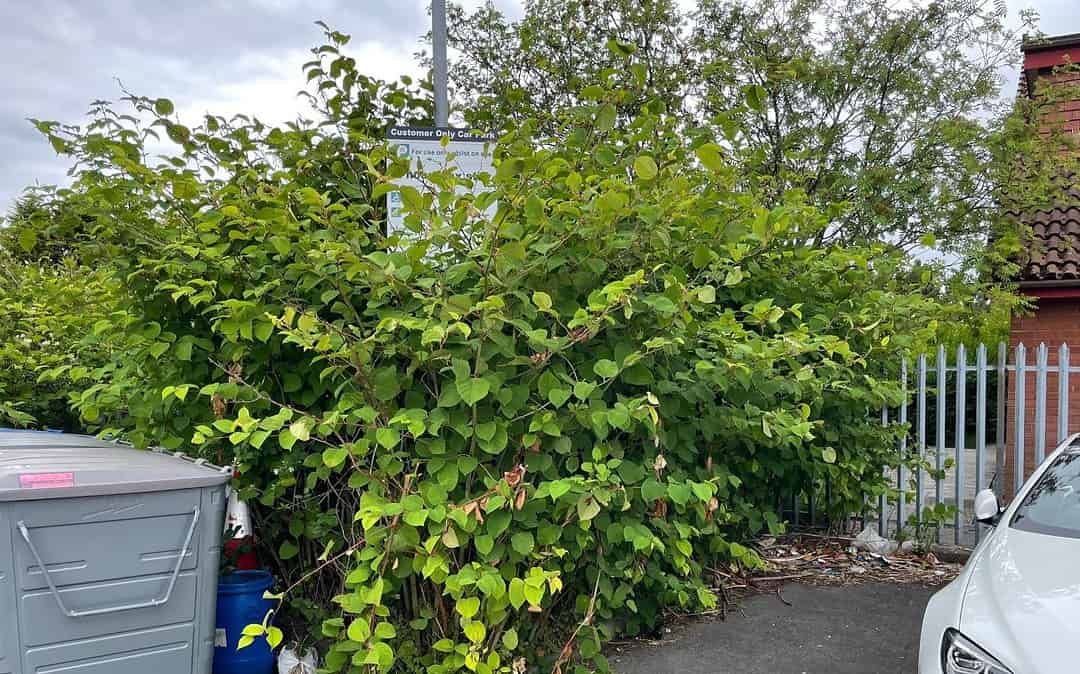Japanese Knotweed Explained
Japanese knotweed.
(Fallopia japonica) is a highly invasive plant from parts of East Asia. It was brought to North America and Europe as an ornamental plant in the 19th century. It was first introduced to the UK as an ornamental plant in the mid-19th century and was widely planted and established in gardens and parks due to its attractive appearance and rapid growth. However, it has since become a significant problem due to its aggressive growth and ability to damage buildings, roads, and other infrastructure.
Japanese knotweed Identification:
It’s a perennial plant that grows up to 3-4 meters tall. Large, heart-shaped leaves grow in a zigzag pattern along the stem. The stems are hollow, bamboo-like, and grow in thick clusters. During late summer, the plant produces small, creamy-white flowers that are arranged in clusters.
March: small shoots are starting to emerge from the well-established crown containing last year’s old canes.
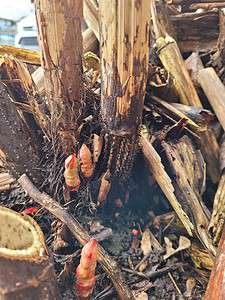
new shoots emerging from the old crown surrounded by last years dead canes
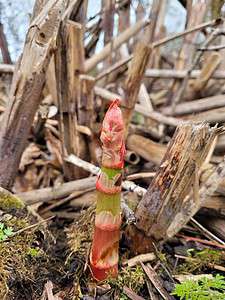
new stem Japanese knotweed
April: the plant are bigger than 12 inches
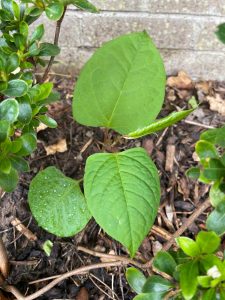
Small Japanese knotweed plant plants
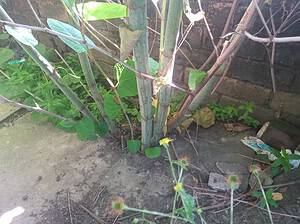
New canes are a lush green colour with pink flecks
June: the plant can be around 2 to 3 meters tall.

Tall Japanese knotweed
September: The plant is in full flower.

Japanese knotweed in full flower
January: The rhizomes of the plant are hibernating underground.

last years dead canes
Spread:
Japanese knotweed spreads rapidly through underground rhizomes, which can grow up to 3 meters deep and 7 meters wide. This can sometimes make eradication difficult, as even small rhizome fragments can regenerate into new plants. It is not spread by seed as they are infertile.
The Impact:
Japanese knotweed, may on rare occasions, cause damage to buildings, roads, and other infrastructure. Its extensive root system can grow through gaps in concrete, tarmac, and other materials, causing structural damage. It can also outcompete native vegetation, reducing biodiversity and disrupting ecosystems.
Bee’s and Butterfly’s love Japanese knotweed
While Japanese knotweed is generally considered an invasive species, it does have some ecological value as a source of nectar for pollinators.
The flowers of the plant produce nectar, an important food source for bees and other pollinators. The nectar comes from small flowers that grow on the plant in late summer and early autumn. Each flower produces a small amount of nectar, which attracts many bees, wasps, and other insects that feed on it.
Control:
Controlling knotweed can occasionally require a combination of physical, chemical, and biological methods. Physical methods include digging up the plant and its roots, burying the waste in a deep landfill, or inserting a Geotech vertical weed barrier. Licensed professionals should only carry out chemical treatment involving the use of herbicides to kill the plant.
Biological methods include:
introducing natural predators or pathogens that are not yet widely available and only tend to work in warmer climates.
Japanese knotweed can be a highly invasive plant that may cause significant damage to buildings, roads, and other infrastructure. It is difficult to eradicate due to its aggressive growth and extensive root system. However, by using a combination of physical, chemical, and biological methods, it is possible to manage and control its spread. Acting quickly to prevent further damage and protect the environment is essential.
In the UK, If you’re selling your property and there’s knotweed present, it can significantly reduce the value of your property and make it difficult to sell. This is because Japanese knotweed is known to cause structural damage to buildings, roads, and other infrastructure.
In addition,
Mortgage lenders may refuse to provide loans on properties where Japanese knotweed is present without a Management plan in place.
Because the plant it is considered a serious risk. This can limit the number of potential buyers, and those who are interested may offer a lower price due to the perceived risks and costs associated with managing or eradicating the plant.
Furthermore,
As the plants presence can also impact neighbouring properties, it’s essential to disclose its presence to potential buyers. Failing to do so can lead to legal disputes and further decrease the property’s value.
If you are selling or purchasing your property, we can more often produce a complete survey, management plan, and Ten-year insurance-backed guarantee within 24 hours.
If you’re planning to sell your property in the future you need to take steps to manage or eradicate it before putting it on the market. Here are some steps you can take:
1. Get a professional survey: It’s essential to have a professional survey of the property to identify the extent of the problem. This will help offer an effective and efficient way of managing or eradicating it.
2. Choose a reputable specialist: Select a reputable and experienced specialist in Japanese knotweed. They can advise you on the best course of action and provide a management plan that meets your needs.
3. Follow the management plan: Implement the management plan provided by the specialist, including treatment by chemical control.
4. They will keep records of all the actions taken to manage or eradicate the plant, including dates, methods used, and results obtained. Providing evidence to potential buyers and mortgage lenders that you have appropriately addressed the problem.
5. You must disclose the presence of the plant: When selling your property, disclose the existence of Japanese knotweed to potential buyers. This will help avoid legal disputes and ensure the buyers are fully aware of the situation.
The length of the management plan for treatment with chemicals
This will depend on various factors, including the infestation’s severity, the plant’s location, and the type of treatment used. Generally, a management plan for treating Japanese knotweed with chemicals can range from one to several years.
Herbicide treatments are typically applied twice annually for several years to achieve effective control of Japanese knotweed. The exact number of treatments and the length of the management plan will depend on the type of herbicide used and the specific needs of the site.
It’s important to note that Japanese knotweed can be difficult to eradicate ultimately, and even after treatment, regular monitoring and maintenance may be required to prevent regrowth. Therefore, it’s essential to work with a reputable and experienced specialist in Japanese knotweed control who can provide ongoing support and advice throughout the management process.
Overall, the length of the management plan for treating Japanese knotweed with chemicals will depend on various factors, and it’s essential to follow the advice of the specialist to ensure the most effective and efficient treatment of the plant.
There is a lot of misinformation on the internet regarding Japanese knotweed.
This can make it difficult for homeowners and property managers to understand the risks associated with this invasive plant. One common misconception is that Japanese knotweed can cause significant damage to buildings and other structures by growing through concrete and other hard surfaces. While Japanese knotweed is undoubtedly a tenacious plant that can cause damage to buildings if left unchecked, it’s important to note that it typically does not grow through solid materials like concrete. Instead, it can cause damage by exploiting existing cracks and weaknesses in the structure, growing close to the foundation, and undermining it over time.
Another common misconception is that Japanese knotweed is impossible to eradicate once established. While the plant can be challenging to control, managing and eliminating it with the right approach is possible. This may involve a combination of chemical treatments, physical removal, and ongoing monitoring and maintenance to prevent regrowth.
It’s crucial for homeowners and property managers to seek out accurate and reliable information when it comes to Japanese knotweed and to work with qualified professionals who can provide effective management and control solutions. By taking proactive steps to manage Japanese knotweed and prevent its spread, we can help to minimize the risks associated with this invasive plant and protect our homes and natural ecosystems from its damaging effects.
